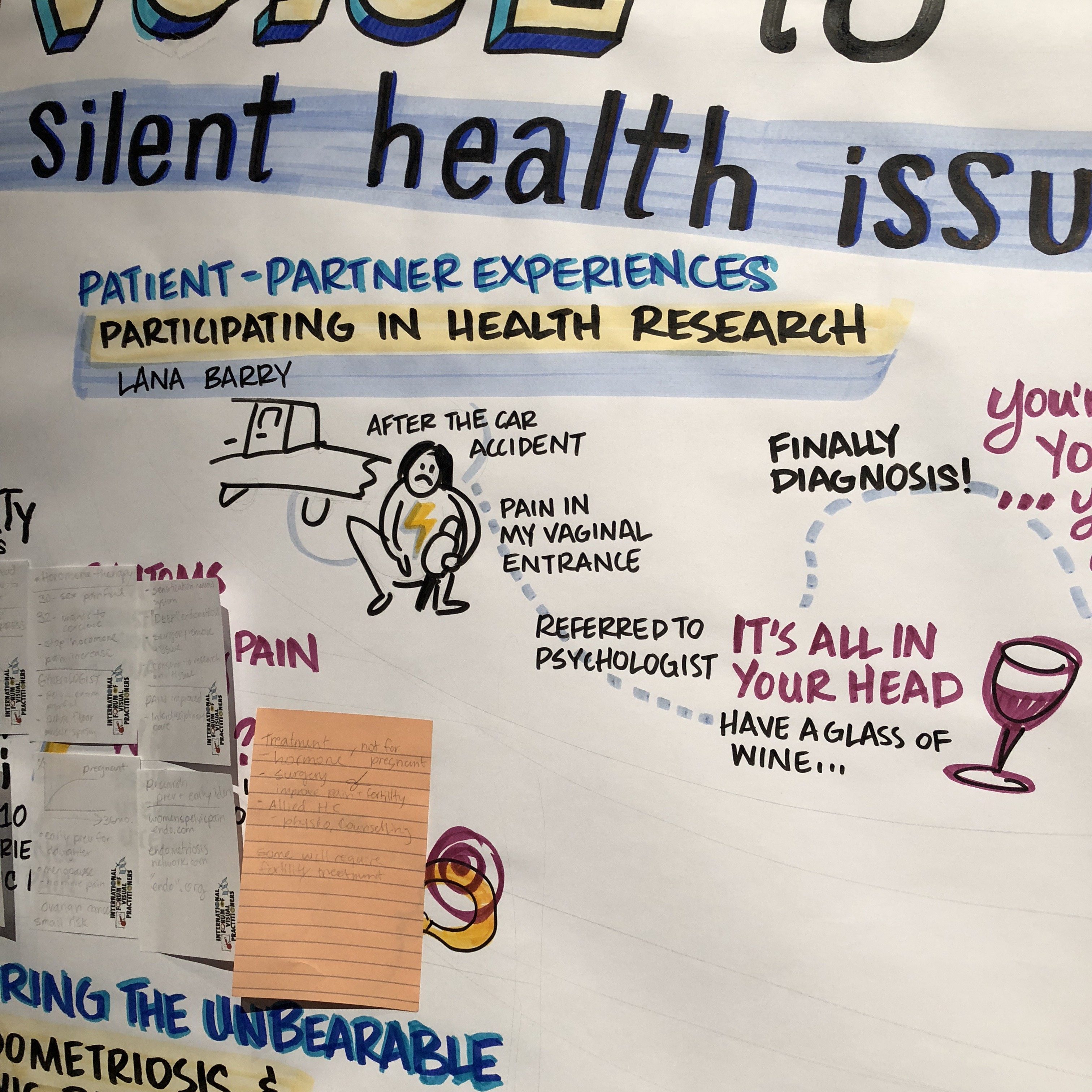
On October 6th, 2017 Dr. Lori Brotto and the Women’s Health Research Institute (WHRI) launched the #ItsNotInYourHead (INIYH) campaign which shared the results of the five year clinical trial Cognitive behaviour therapy Or Mindfulness FOR Treating PVD (COMFORT) which taught women with provoked vestibulodynia (PVD) mindfulness meditation or cognitive behavioural therapy (CBT) as a means of coping with the pain and distress of PVD.
To share this message, Dr. Brotto enlisted the help of Lana Barry, a participant in COMFORT, to be involved in an end-of-grant Knowledge Translation (KT) project funded by the Michael Smith Foundation for Health Research (MSFHR), to share results of the study and raise awareness about PVD.
Getting involved
Lana had faced a long and painful journey to diagnosis. As a single woman participating in the COMFORT study, she quickly developed a passion for self-advocacy and a desire to let women know that their own sexuality and health was a vital part of their identity, regardless of whether they were in a relationship or not. So, when Dr. Brotto decided to enlist the help of ThinkingBox.com to develop an educational video sharing the findings of COMFORT, Lana was the perfect voice to narrate the video.
The COMFORT study team approached Lana to assist with developing the storyboards leading to the video creation, and together they embarked on a co-creation process to translate the study findings. The video would begin with Lana sharing her own story, urging women to speak to a healthcare provider and to know that their pain is real, even if it is not evident to a doctor on an exam.
“I wanted to be the voice,” Lana explains. “I was feeling a lot of sadness that these women were going through such private matters, and were not able to say the word[s provoked vestibulodynia] out loud….I thought, ‘this has to change.’”
With the completed video, Dr. Brotto successfully applied for a MSFHR Reach Award to support a social media knowledge dissemination campaign. Lana was identified as the Research User Co-lead, and with a team of staff skilled in social media and KT at the WHRI, the INIYH campaign was launched.
Lana’s experience

Prior to participating in the COMFORT study Lana says that finding any information on PVD was difficult, and some of the most valuable information she found came from personal blogs written by other women with PVD. With the knowledge she gained about social media through INIYH, she was able to amplify this information with the hope to help bridge the knowledge gap for others. Her voice added another layer of credibility to the campaign, and allowed her to share her lived experiences with PVD.
Incorporating a patient’s experience and unique perspective into KT work is not only beneficial for researchers – it can profoundly impact a patient’s life. While Lana’s voice added value to INIYH activities, it also encouraged her to be vulnerable with others, and for Lana, this was a very good thing. She explained that prior to diagnosis she felt so much shame from being told the pain was ‘all in her head’ that she hid it from those closest to her.
“At that time [when I was asked to record the voiceover] I said yes because I knew my future self would be able to handle it,” Lana says, “but that person in the moment had a lot of work to do to get there.”
What we learned
INIYH was a novel partnership between a graphic design team, researchers, clinicians, and a patient partner. The team not only faced the steep learning curve of designing a social media campaign from scratch, but also facilitating a patient partner relationship that was respectful and safe.
One important lesson we took from the experience is that providing training is an essential step in building a relationship with your patient partner. WHRI provided training on Twitter and Facebook, which Lana found invaluable, and urges other researchers to offer the same to their patient partners. We helped amplify her profiles by tagging and retweeting her, and offered guidance for content creation and other activities. She credits this experience for the creation of a virtual toolbox which will help her continue her advocacy work.
Lana suggests one way to improve the patient partner experience is to allow patients “greater involvement in the process.” She emphasizes that time spent in-person with the campaign team helped to expedite the learning curve and provide a greater understanding of her role as well as bolster team cohesion. Further, ask your patient partner what you can do for them. For us, this included: accommodating Lana’s schedule for meetings, providing regular campaign updates, and assisting with any personal story writing.
We also took guidance from a variety of useful sources, including the Strategy for Patient-Oriented Research, Knowledge Translation Canada, and this podcast with the champion of the It Doesn’t Have to Hurt campaign, Dr. Christine Chambers. Creating a thorough job description for patient partners so that they have clear expectations for their role and involvement; making room in the budget to adequately compensate them for their time and efforts; and creating time for face-to-face communication are all ways that researchers can better facilitate patient partner relationships.
Beyond the campaign
We are grateful for Lana’s bravery and willingness to share her story. Throughout the process people have reached out to Lana to share their own stories, inspired by her vulnerability. And, for Lana, she credits INIYH for giving her confidence and helping her to take a step forward to deal with difficult emotions.
“Through this process I have found my voice,” she says. When asked if she would recommend becoming a patient partner to other patients she does not hesitate to say yes, “it will change their lives for the better.”

Now that the campaign has officially ended Lana will be the champion of a private Facebook group where she can continue her advocacy work. The group – which was one of the campaign initiatives – is designed for people with PVD to connect and find solidarity with others. With Lana’s help, INIYH will continue to let women know that their pain is real, and treatment is available.
Check out the INIYH campaign on Twitter, Facebook, and Instagram to learn more about PVD, and follow Lana on Twitter and Instagram to learn more about her story.
